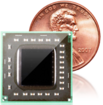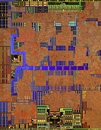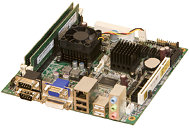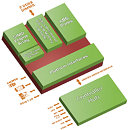Wednesday, January 19th 2011

AMD Delivers the World's First and Only APU for Embedded Systems
AMD today announced immediate availability of the new AMD Embedded G-Series processor, the world's first and only Accelerated Processing Unit (APU) for embedded systems. The AMD Embedded G-Series, based on AMD Fusion technology, delivers a complete, full-featured embedded platform and incorporates the new low-power, x86 CPU based on the "Bobcat" core with a world-class DirectX 11-capable GPU and parallel processing engine on a single piece of silicon.
"AMD's commitment is to ensure the game-changing technologies we develop for consumers and the enterprise are also available for the vast and growing embedded market," said Patrick Patla, corporate vice president and general manager, Server and Embedded Division, AMD. "Today, we have a record number of embedded launch partners. They are using the unique advancements of the AMD Embedded G-Series APU to develop a brand new generation of highly differentiated, energy-efficient, small form-factor embedded systems that can deliver the vivid visual experience expected in our always-connected world."
"AMD's commitment is to ensure the game-changing technologies we develop for consumers and the enterprise are also available for the vast and growing embedded market," said Patrick Patla, corporate vice president and general manager, Server and Embedded Division, AMD. "Today, we have a record number of embedded launch partners. They are using the unique advancements of the AMD Embedded G-Series APU to develop a brand new generation of highly differentiated, energy-efficient, small form-factor embedded systems that can deliver the vivid visual experience expected in our always-connected world."
- This new class of accelerated processor combines more compute capabilities on a single die than any processor in the history of computing and represents opportunity for major advancements in embedded systems.
- No solution with this level of advanced computing is available for the embedded market today.
- Numerous embedded systems based on the AMD Embedded G-Series are available today or expected to launch in the coming weeks from companies including Advansus, Compulab, Congatec, Fujitsu, Haier, iEi, Kontron, Mitec, Quixant, Sintrones, Starnet, WebDT, Wyse, and many others.
- Expected products include graphics-intensive solutions like digital signage, internet-ready set top boxes, mobile and desktop thin clients, casino gaming machines, point-of-sale kiosks, and small form factor PCs, as well as numerous single board computers (SBCs).
- Shane Rau, research director of Computing and Storage Semiconductors at IDC, expects shipments of processors for embedded systems to increase at a double digit rate each year for the next five years.
- This brand new platform continues AMD's mission to lower power, shrink physical component area, and reduce the costs of designing and producing x86 embedded systems.
- The open development ecosystem for the AMD Embedded G-Series platform includes multiple BIOS options, support for various Microsoft Windows, Linux, and real-time operating systems, the integrated OpenCL programming environment, and source-level debug tools.
- AMD provides a dedicated design support team to help customers create distinctive new products and bring them to market quickly.
- Online resources include an embedded developer portal, AMD embedded product selection guide and customer-submitted details on available boards and complete systems.
- 1 or 2 x86 "Bobcat" CPU cores with 1MB L2 cache, 64-bit Floating Point Unit
- Up to 1.6 GHz
- 9W and 18W TDP
- Array of SIMD Engines
- DirectX(R) 11 capable graphics
- Industry-leading 3D and graphics processing
- 3rd Generation Unified Video Decoder
- Power management features, including C6 and power gating
- DDR3 800-1066 memory with support for 64 bit channel and 2 DIMMs
- Ball Grid Array (BGA) package
- 890mm physical footprint, including the AMD Fusion I/O Controller Hub




49 Comments on AMD Delivers the World's First and Only APU for Embedded Systems
also dx11 better supports multithreading. I see no mention of directCompute for gpu acceleration in the dx10 article AFAIK dx10 does not support DC.
Can't they make these things bigger? :roll:
Embedded platforms are often built with an expectation of 5 or more years of life. So, in that sense, by the time these things are halfway through their life, there is still a need for future graphics.
If you were a cable company building an IPTV set top box that needed to stream content from 2011 through 2016, would you want DX10 or DX11?
I would love to see a world of just one damn instruction set.
btw its for embedded entertainment thing, like karaoke box or even arcade machine, so its need latest visual enchantment
silly me.
Either way, this thing is likely solid as can be.
However silly comments like this one and the one above it, are that silly. AMD knows how to make chips.
Give the "world's first" a chance.
mole hill meet mountain.
and btw if you mean world first is unproven and unreliable, then why the hell AMD gain market share with their opeteron64, i mean isn't server need more reliability than embedded system ??